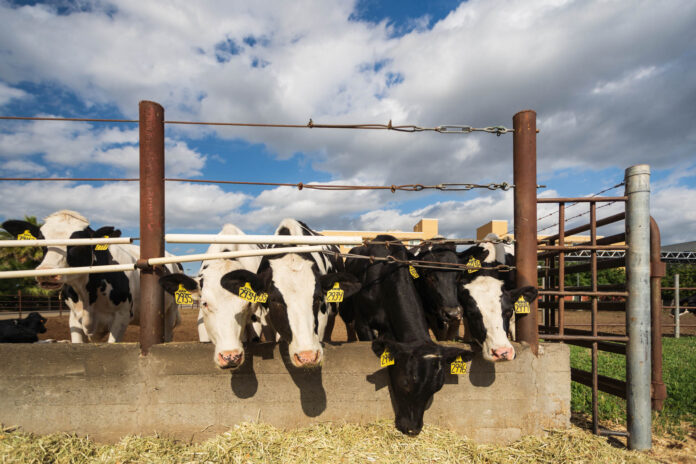Research suggests that lemongrass may also be a successful feed additive to reduce cow methane emissions in the future
The lab of UC Davis Animal Science Professor and Associate Dean of the College of Agriculture and Environmental Sciences Ermias Kebreab has successfully identified seaweed as a feed additive that can reduce the enteric methane emissions of cows—methane released from cow burps—by as much as 82%. These findings were released March 17 in the journal PLOS ONE, and represent a viable opportunity for farmers to meet California methane standards and reduce the amount of short-lived climate pollutants in the atmosphere.
“I work with cattle, both beef and dairy, to find new feed additives that can increase the sustainability of livestock,” said Breanna Roque, a fourth-year Ph.D. student in the animal biology department, who is working alongside Kebreab on the project. “One of the goals of the lab is to see if we can reduce methane production coming from cattle through the use of feed additives.”
Students working in Kebreab’s lab are testing the impacts of different feed additives on the enteric methane emissions of cows.
“About 95-98% of methane comes from the front of the animal,” Roque said. “A big myth is cow farts are contributing to climate change—it’s actually the burps.”
By reducing enteric methane emissions, Kebreab’s lab is focusing on reducing the methane emissions that are released through the cow’s mouth.
“Livestock contributes about 14.5% to greenhouse gas emissions worldwide and about 4% in the U.S.,” Kebreab said. “About 5.7% of global greenhouse gases comes from enteric methane [released by ruminant animals].”
Kebreab hopes the discovery of seaweed as an effective feed additive will reduce the global enteric methane emissions from ruminant animals—typically farm animals like cows, sheep and goats—from 5.7% to 2.5-2.8%.
Roque ran the day-to-day operations of the study by implementing the seaweed into the cows’ diets and ensuring the animals’ safety throughout the 21-week project.
“With any new feed additive, it takes cows a little bit [of time] to get used to the smell and the flavor of something new into their diet,” Roque said. “The seaweed comes freeze-dried and ground so it’s more like a powder than strips of seaweed. I took this powder and mixed it with molasses, which has got a bit of a sweeter smell and taste that cows really enjoy.”
Roque added this mixture to the cows’ diets twice a day and encouraged cows to visit a GreenFeed machine in order to measure their methane emissions.
“The animal voluntarily walks up to the machine and eats [alfalfa pellets] from this tray,” Roque said. “While it’s [eating, it is] also undergoing other processes such as burping and regurgitating. While it’s doing this, the machine is able to capture the burps or the gasses that come from the mouth and measure them.”
By reducing livestock enteric methane pollution, the project strives to help farmers meet new California legislation regarding climate pollutants.
“[In California], legislation has gone through that states that short-lived climate pollutants, such as methane, need to be reduced by 40% in the next 10 years,” Roque said. “If seaweed is reducing such a significant amount of methane, and we are able to get it to the market for these farmers, it provides them a viable way to meet these standards.”
Mallory Honan, a second-year Ph.D. student in the animal science department who is also working alongside Kebreab, studied the effects of lemongrass as a feed additive to reduce enteric methane emissions.
“[Lemongrass] has a lot of secondary compounds, such as tannins,” Honan said. “What we were hoping to see is that these secondary compounds would elicit a change in the rumen microbiome environment, thus reducing methane emissions.”
While Honan’s lemongrass study did not elicit a methane reduction as drastic as seaweed, Honan predicts it is due to the location of the lemongrass sourced for the project.
“The [lemongrass] that we had sourced wasn’t very concentrated in those secondary compounds [tannins], because it was grown in California and not in a tropical, native area,” Honan said.
While students in Kebreab’s lab continue to test the effectiveness of different feed additives, the success of seaweed has allowed Kebreab to explore ways to produce and distribute it. He is working with a couple of companies to do so as quickly and safely as possible.
“I feel very lucky to be a part of this and also very excited for the livestock industry to be able to provide research that contributes so greatly to more sustainable practices,” Roque said.
Written by: Maddie Duley — campus@theaggie.org




